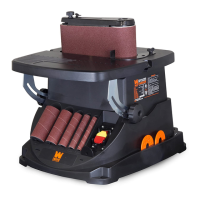11
OPERATION
CHANGING/REPLACING SANDING DRUMS AND SLEEVES
1. As always, disconnect the sander from the power source.
2. Remove the spindle sanding components in reverse order of the installation (Fig. F).
3. Clean all sawdust and debris from the opening for the table insert, the throat plates and any other areas where it
may have collected.
4. Select which new sanding diameter you would like to use and install all necessary components (Fig. F).
5. Secure the sanding drum with the appropriate spindle washer and nut. Tighten until the rubber sanding drum
places enough pressure on the sanding sleeve to prevent it from freely spinning without the drum.
NOTE: The 1/2 inch sanding sleeve does not use a sanding drum. Instead, it mounts directly onto the spindle shaft.
INSTALLING THE BELT SANDER
Belt sanding is helpful for sanding straight lines or curves
along the outside edge of a workpiece. The belt sanding
attachment oscillates up and down while the belt moves
horizontally across the workpiece. The work stop sup-
ports the workpiece during sanding, helping to prevent
it from being ejected by the moving sanding belt (Fig. H).
To use the belt sander, remove the spindle sanding com-
ponents and follow these steps:
1. Unplug the sander from the power source.
2. If spindle sanding components are installed, remove them and place them back in their respective storage slots.
3. Place the belt sanding attachment over the spindle. Ensure that the drive splines on the attachment mesh with
those on the fan. Ensure that the alignment tab is held by the alignment slots. Secure it in place with the spindle
knob (Fig. H).
4. Install the work stop and secure it in place using the wing bolt. Test-run the belt sander to make sure it is operating
properly before applying any load.
Fig. H
Belt Sanding
Attachment
Workstop
Spindle Knob
BELT SANDING STRAIGHT LINES
1. Turn sander ON and allow it to reach full speed before
apply a load.
2. Support the workpiece against the workstop (Fig. I). Us-
ing both hands, guide the workpiece against the rotation
of the sanding belt. Do not force the workpiece against
the sanding belt. Allow the machine to do the work.
3. When finished, turn the sander OFF.
Fig. I
Belt Rotation
Direction

